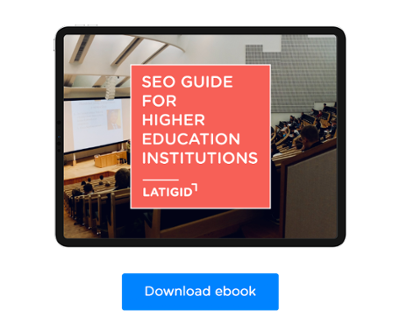
In the 2021 Survey of College and University Admissions Officers, by Inside Higher Ed, it is possible to see that the concerns over reduced enrollment from admissions officers and admissions directors are pervasive. This year, over 90 per cent of enrollment officials say they are either moderately or very concerned about meeting new student enrollment goals.
In the same survey, only 11% of enrollment officers said they were “very satisfied” with the marketing tools their educational institution used.
According to Mark in Style, a recruitment agency that specializes in connecting the best employers and job seekers in the UK education sector, the number of students enrolled in higher education is expected to more than double by 2025, to 262 million, and I don’t want your institution to miss on that.
With institutions of all possible profiles, the process of getting new students starts to become more challenging than it used to be. If you are not reaching your enrollment goals, that means you may need to change your marketing strategy. That’s where your school’s SEO strategy comes in.
Related: SEO for Schools: Increase Your Institution's Website Traffic
The decision process of potential students and parents in choosing the best institution has changed radically, with more than 65% of searches taking place through search engines, making digital recruiting replace traditional recruiting.
If you're starting to rethink your institution's digital placement and aren't sure where to start, here are some valuable tips for increasing your school/college's enrollment volume.
1. Get found on Google My Business
Google My Business seeks to organize and list, with address, telephone number, website, and other data, companies that appear in the results of a Google search. It guarantees very high visibility (including photos of the institution appearing directly on the results page) and, for a user looking online to choose the institution they will study, it can be the first point of contact with their school or university.
To ensure good visibility on Google My Business, it is important to make a complete registration, with all the validations requested for the profile. In addition, it is important to reinforce that Google displays its results based on physical location (the IP address of the person searching), allowing your site to appear even more prominently when the user is close to your institution at the time of the search. That's why the power of “local search” cannot be underestimated, especially if your school or college is located in densely populated regions.
2. Encourage customer reviews
Online reviews are important for consumer decision-making, especially in the education field. They show what other students think about institutions, how is the teaching, the support, the HR department, among other services institutions might offer - not what the institution says about itself, as it does in advertisements and branded content. This brings a lot more confidence to the decision from students as they will more easily believe in reviews from another student than from an advertisement.
Related: What is Inbound Marketing?
For Google ranking, these ratings are also essential as it helps the search engine understand what users think about the institution, therefore, the reviews it receives on Google My Business count a lot in the ranking. The more reviews and positive ratings it receives, the better positions it tends to earn. Thus, you should encourage your institution’s students to leave reviews online, particularly on Google My Business.
The first action is to enable this option. Not allowing students to report their experiences and impressions can close a path of dialogue with the public and convey a negative image for your school/university, in addition to having negative points with Google.
Also, it's important to answer the reviews to show you care and encourage more students to engage. Compliments always deserve attention and gratitude - try not to leave such comments unanswered, even if it seems unnecessary to respond to them. Criticisms, on the other hand, require closer care by the institution to assess what happened and try to solve the problem.
To encourage reviews, you can also adopt marketing strategies. Send emails and print materials that ask for student participation. Google itself offers a Marketing Kit for creating this type of material.
3. Create Content
What differentials does your institution offer students? Events? Fairs? Job market recognition? Employability rates? Teaching methods? Workshops with experts? Training recognition? Talk about it through relevant content on your school/university website. Publish detailed information about events, fairs that take place and detail each important difference in a post on the institution's blog.
Related: Digital Marketing Strategy for Schools
Adding content guarantees a relationship with current students but also helps to attract new ones, as it shows that the institution is up to date, in tune with news and ideas. In addition, the content produced is shared on social networks and helps in the institution's organic ranking.
4. Do Remarketing Campaigns
Choosing an institution to study is a process that involves research, which means accessing websites once or more and sometimes never returning! And as this is a process that can take from 1 or 2 weeks to 2 or 3 months and sometimes, even more, creating a remarketing campaign to show institutional ads to those who have already visited your site is a very efficient strategy!
Its operation is simple and guarantees that the ads are targeting only the people who have already accessed your site and for a pre-defined period of time. This helps to increase enrollment as it positively impacts users who have already taken an interest in your institution. And you can even target these ads only to users who have visited certain pages, such as a specific course.
5. Optimize the site's Meta Tags
A basic SEO tip, which works from the beginning of search engines: Optimize the title and the description tag to improve SEO and the visitor experience, by making it easier to read the page directly from the results page on search engines.
You can use keywords that are most relevant to that page and create an effective description to quickly explain to the user that this is the page they are looking for. And when there's a search for a private school/university, remember that students and parents have different priorities, so think about the two profiles when optimizing the different pages on the site.
Related: How can universities generate international leads?
SEO is a primary strategy in the construction and evolution of an educational institution's website and has a great impact on the number of enrollments that originate from the digital medium. There are other actions that can be done on social media or through campaigns but remember that the search for educational institutions usually starts with a Google search.
I hope this article has helped in realizing that it is time to adapt your digital marketing strategy. If you have questions or need a partner to help your higher education institution grow, please contact us.




